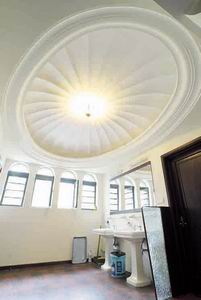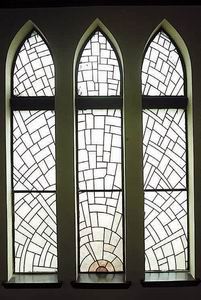Shanghai Daily news

The Spanish-style mansion at 22 Panyu Road had been
intended by Hungarianborn architect Ladislaus Hudec as his own residence but in
the late 1920s he sold it to Sun Ke, son of Kuomintang founder Dr Sun
Yat-sen.(Photo: Shanghai Daily)



The house shows the architect¡¯s talent in interior
design in such details as the round dome in the bathroom (left), the use of
columns in the study (above) and the Gothic-style windows (right).(Photo:
Shanghai Daily)
A love affair involving the son of Chinese revolutionary Dr Sun Yat-sen was
carried on in a beautiful villa designed by one of Shanghai's greatest
architects of the early 20th century, writes Michelle Qiao.
Most of the
architectural treasures of early 20th century Shanghai are concealed behind high
walls just as were many of the beauties who lived in the city in that era. The
beautiful former residence of Sun Ke, the only son of Dr Sun Yat-sen (the
founder of Chinese Kuomintang), is one such hard-to-find treasure.
The
three-story cream-painted villa at 22 Panyu Road is perched in the depths of the
lush gardens of the state-owned Shanghai Biochemical Research Institute which
has used the house as offices since the 1950s.
Famed Hungarian-born
architect Ladislaus Hudec built the house (whose entrance is now on Yan'an Road
W.) in the late 1920s as his own residence. But he did not move in immediately
and later, because Sun Ke had done him a favor, Hudec sold the house to him at a
very low price.
Hudec's innovative architectural skills can be seen
everywhere in the 1,051-square-meter villa.
Most of the windows are in the
Gothic style. Columns in a range of shapes and patterns perfectly grace the
study on the first floor and the hallway on the second.
``Gothic-style
windows were a favorite design of Hudec and he also loved to use columns as
adornments in his houses,'' says Hua Xiahong, an architectural expert from
Tongji University who has conducted a study of the building.
Hua says that
the overall Spanish-style design has been cleverly mixed with other
architectural elements.
``Hudec was an eclectic designer,'' she says. ``Some
of the columns are in the typical Spanish style with spiral patterns and some
are in the Greek Ionic style. And the chimneys resemble the Islamic style.''
The same is true of the various fireplaces. Some feature patterns from the
Renaissance, some are in simple, white marble and some have decorative patterns
of flowers which belong to no specific style. A sculpture of Venus used to stand
in a fountain in front of the house but both were demolished a long time ago.
``It seems that he designed the house in a free, creative mood,'' Hua says
with a chuckle.
Perhaps because the house was originally meant for himself
and the architect did not have to please a client, he felt he was free to
indulge himself by experimenting with his own ideas.
The ample bathroom on
the second floor has a beautiful round dome that looks like a giant white shell.
The floor is paved with a lovely matching pattern of Mosaic ceramic tiles in
three different degrees of red.
Another bathroom on the top floor still has
an old-fashioned copper water faucet and bath tub.
The house has a second
staircase so the servants could bring dishes of food to the main rooms.
Born
in 1891 in South China's Guangdong Province, Sun Ke was the son of Dr Sun
Yat-sen and his first wife, Lu Muzhen. Dr Sun divorced Lu in 1913 so he could
marry Soong Ching Ling, the second of the three famous Soong sisters.
Sun Ke
was educated at the University of California and Columbia University in New
York. His father had given him an abiding interest for books and he was a
renowned book lover among senior officials of the former Kuomintang regime.
Sun Ke lived in the house on Panyu Road where he had installed his ``second
wife'' Lan Ni but he had to spend most of the week in Nanjing where he was an
official with the then Kuomintang government. However, he was able to get back
to Shanghai on most weekends.
Sun had met Lan in 1935 at a friend's party
and they had a daughter together.
Although he studied and worked hard, he
was still the ``crown prince'' in the eyes of many because his father was the
pioneer of the Chinese revolution which saw the overthrow of the Qing Dynasty
(1644-1911).
With his full-moon face he resembled his father and his
up-and-down political fortunes and his private life also mirrored his father's
career.
The younger Sun was mayor of Guangzhou, capital of Guangdong
Province, for three terms between 1921 and 1926 and he proved to be a good
public official. He improved the education system, the environment and public
security.
But he was also well known for having an irritable temper,
according to historian Shen Feide's book ``The First Family of the Republic of
China Before 1949 -- Dr Sun Yat-sen's Relatives and Descendants.''
``A
scandal about Sun Ke and his concubine Lan Ni was published in local newspapers
on April 23, 1948, the day of vice-presidential election,'' Shen wrote in his
book. ``Sun lost the vice presidency to Li Zongren partly because of this
scandal.''
This incident also led to Sun breaking up with his beautiful
``second wife'' Lan.
Sun Ke moved to the United States in 1952 with ``first
wife'' Chen Shuying where they lived with their daughters. Because he hadn't
saved much money, he wasn't able to afford a grand house and he had to help with
the housework. However, his life in the United States sounds quite idyllic and
he was able to spend most of the time working at his favorite hobby -- book
reading.
But his political ambitions hadn't ended completely. He went to
Taiwan in 1965 and was appointed the chief of the examination administration by
the then Kuomintang leader Chiang Kai-shek. Sun died of heart attack in Taipei
on September 13, 1973.
Sun Ke's ``beautiful butterfly'' Lan Ni returned to
Shanghai in 1986 and died in 1996 at the age of 85. She always kept a note
written to her in happier times by Sun. The note reads: ``I only have wife Chen
and second wife Lan. I don't have a third one. This is a proof of my love for my
wife Lan.''
Yu Jinhua, an officer of the biochemical institution, says Sun
Ke's children used to visit the house once every couple of years.
Standing
in front of the period house and the innovative decorative ideas it contains,
Hua sighs at the arguments over architectural trends.
``Some modernist
architects have severely criticized this classic, overly decorative style but
lately it's becoming more and more popular,'' she says.
No trace exists
today of the building's past glories or of the scandal surrounding a sorrowful
love affair from a bygone era. Only the garden and the building created by a
free-wheeling architectural genius of old Shanghai survives.



